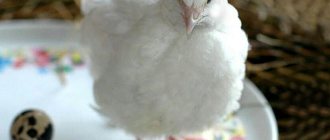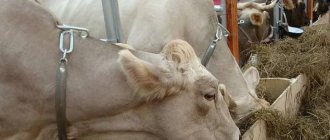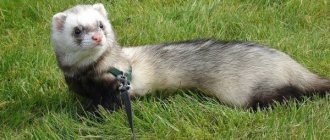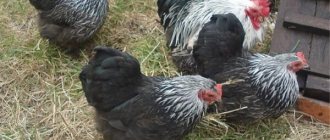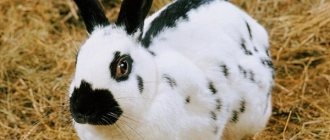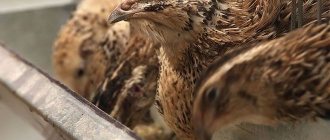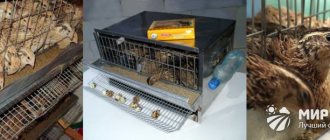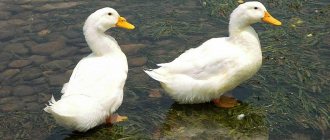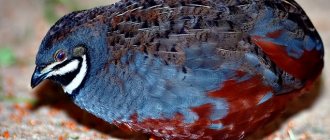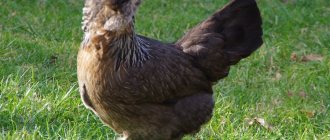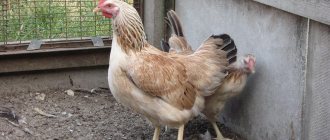The tuxedo quail is a cross between English black and white quail. The result is a new breed of birds with an unusual coloring that attracts the eye: a dark brown back and white neck, breast and lower body. It resembles a tuxedo, hence the name of the breed.
The description of tuxedo quails indicates the following characteristics: they have an egg-meat direction, the live weight of females reaches 160 g, in males it is less, up to 150 g. At the same time, female tuxedo quails, starting from 40 days of age, lay quite a lot of eggs, at least 280 pieces per year, weighing 10 g.
Exterior and performance
Adult males weigh 180-210 g, females - 200-220 g. These figures are slightly less than the original varieties from which the tuxedo quail came. However, they have a much higher percentage of egg fertilization, which can reach 90%, while for the “forefathers” it is only 75%. This is the second advantage of the breed, in addition to its decorative appearance.
Egg weight is 10-11 g, egg production is about 270 eggs per year. Females begin laying eggs at 6-7 weeks.
It is impossible to distinguish females and males based only on color. Only upon reaching sexual maturity can they be separated, based on the presence of a cloacal gland under the tail, which is found in males.
Close-up photo of Tuxedo Quail.
Japanese subspecies
The Japanese quail is considered the ancestor of all modern poultry. She got her name because of the place where she was bred. Scientists have worked to qualitatively improve egg production. Further breeding and selection work made it possible to improve the parent subspecies and create other varieties.
Quail is very unpretentious in maintenance. The color of its plumage is close to that of its wild “relative”. It combines ocher, brown, brown and white strokes. There are several dark brown spots in the crop area. The bird's body is elongated, its tail and wings are short. The feet are pink, the beak is dark, and the eyes are dark brown.
Japanese quail under optimal conditions demonstrates record egg production: 300 or more pieces. in year. The product is small, from 8 to 12 g. And the birds themselves are small: males weigh 115-120 g, females weigh no more than 145 g. Puberty and egg laying in laying hens occurs at the age of 1.5 months.
Attention! On average, 90% of Japanese quail eggs are fertilized. Chick hatch rate is 70%
Conditions of detention
The tuxedo, like its quail relatives, is a heat-loving bird. At temperatures below 15 0 C they stop laying eggs. Otherwise, the conditions of detention are simple.
Cell
It is better to keep tuxedo quails in cages than in an aviary. The design does not take up much space. To keep one family - a male and four females - a cage measuring 30x30 cm and a height of 25-30 cm is sufficient. It is advisable to attach the feeders outside, since quail often rake up food. Depending on the design, drinking bowls are installed both outside the cage and inside it.
Place
Birds are shy, so loud noises and especially sudden movements should be avoided. Even dogs and cats can disturb them. Because of this, when keeping the cages at home, it is advisable to place them in a quiet, calm place. The room must be draft-free. Heated in winter, ventilated in summer. The optimal temperature is 18-22 0 C and relative humidity 50-70%. Quails do not like dry air or high humidity. If the air is very dry, containers with water should be placed near the cages and wet cleaning should be done more often. Lighting can be natural, but not bright.
Daylight hours are at least 17 hours. In this regard, artificial supplementary lighting is necessary in winter. With round-the-clock lighting, the birds will lay eggs well, but feed consumption will increase, and the body will quickly wear out.
Feeding
Tuxedo quails have a very fast metabolism. Therefore, they need food that covers all their needs. It is better to take factory-made feed for laying quails than to experiment with recipes yourself. 25 grams per bird. feed per day (for comparison, Texans eat about 35 grams).
They feed twice a day. You can diversify your diet with grated root vegetables (carrots, beets), cabbage (soft leaves) or pumpkin. Quails will not refuse halves of large cucumbers and greens - lettuce, nettles and dandelions. There must be clean water in the cage at all times. If there is no nipple or microcup drinking system, the water should be changed twice a day.
The cage must be cleaned every day or every other day. The structure itself can be washed and disinfected once every three months. Once a week, quails can be given sand baths, thanks to which they clean their feathers and get rid of parasites.
Quails are unpretentious birds and, provided all conditions are met, even a beginner can cope with their maintenance.
Where to place the cells
Quails are shy, and representatives of the tuxedo breed are no exception in this sense. Sharp sounds, constant noise, excessive attention from people, as well as visits from small predators are stressful for them and cause a decrease in egg production. Frightened birds eat poorly and lose weight. To prevent this from happening, the cages are placed in a room where the birds will be quiet and calm.
The room must certainly be ventilated, but without drafts. In winter, additional heating will be required. When turning on electric heaters, it is important not to forget about maintaining optimal humidity, ranging from 50 to 70%. To do this, bowls with water are placed near the cages, and wet cleaning of the room is carried out at least once a day.
As for lighting, it cannot be bright, since the habitat of quails in natural conditions is tall grass. That is why the cages are placed away from the light source and so that the direct rays of the sun do not fall on the birds. If the room is too light, the quail will become restless, aggressive, and pecking will begin, which can lead to mass death of the livestock.
The recommended length of daylight hours is about 17 hours, both in winter and summer. Wanting to achieve record egg production, some poultry farmers use round-the-clock lighting. However, laying hens that “work” at the limit of their physiological capabilities for a long time consume more feed, and their body wears out more quickly.
Breeding
Since tuxedo quails have lost their brooding instinct during the selection process, incubators are used for breeding birds.
The eggs are collected within one to two weeks, and during this time they are stored in a cool place, but not in the refrigerator. Before laying, the incubator and eggs are disinfected with special solutions, for example, Brovadez Plus. The incubator is warmed up and only then filled with eggs. First, one side of each egg must be marked with a marker in order to subsequently turn it over correctly.
Incubation lasts 16-17 days, like the Japanese breed. The first hours set the temperature at 37.7 0 C. Then it is reduced to 37.6 0 C, and the humidity is set within 55-60%. These indicators are maintained for nine days. On the 10th day, the temperature is again reduced to 37.5 0 C, and the humidity to 45-50%. The next change in indicators occurs on the 16th day, when the humidity should gradually begin to increase, and the temperature, on the contrary, should be reduced. On the 17th day it is necessary to set 37.4 0 C and 70-80% humidity.
In addition to constant monitoring of temperature and humidity, eggs must be turned regularly, at least 3-4 times a day. And stop doing this only on the 16th day. During turning, the incubator should be left open for five minutes at the beginning of incubation, gradually increasing this time to ten minutes by day 16.
Species classification
The division of quail breeds according to poultry purpose is the most popular classification. The following categories are distinguished:
- Egg. It includes quails with a productivity of at least 270 eggs per year. The second sign is small body size: up to 150-160 g in laying hens, up to 120-130 g in males. Such birds begin to lay eggs early, at about 1.5 months. But females are not brood hens. The egg weight reaches 10-12 g.
- With meat productivity. Types of large-sized quails and their broiler hybrids. With the correct fattening program in 2-3 months. individuals reach a mass of about 260 g (males) or 320 g (females). Representatives of certain quail breeds gain weight of 0.5 kg. The number of eggs per year rarely exceeds 220 pieces. But the product is relatively large - up to 18 g.
- Meat-egg. They have average indicators in comparison with the other two groups. The live weight of a male quail reaches 180 g, a laying female - 210 g. Egg production varies between 220-270 pcs./year. These quails are suitable for those who want to try dietary meat and get enough eggs.
- Decorative. Bred purely to decorate the poultry yard. Breeds: Californian, Virginia.
Attention! Crossbred quail breeds do not justify the cost of their maintenance. Not purebred birds weigh poorly and are low-productive as laying hens
You can count on the efficiency of a home farm only with original breeds.
The division of quails into groups is arbitrary. The taste of meat in birds is similar, its dietary properties are approximately the same. Only the carcass size of egg quail breeds is smaller, and their marketability is lower. Some experts do not classify meat and egg species as a separate category. Birds are bred by interbreeding or intrabreeding. Sometimes they are classified either as purely meat or purely egg.
Development of young animals
The weight of a hatched tuxedo quail is 7-8 g. After the chicks hatch, they are kept in the incubator for several more hours to dry, after which they are transferred to a brooder - a kind of nursery for newborns, where it should be very warm. Here they will spend the first weeks of life. The poultry must be sorted. Weak chicks and those with obvious developmental anomalies are very difficult to hatch. In most cases, they die in the first days of life. It is impractical to keep such animals, so many experienced quail breeders get rid of them without hesitation.
What breed is this
The Chinese painted quail is one of the smallest of all quail species. Their popularity among poultry farmers is due to their beautiful appearance. They are unpretentious when in captivity. Next, let's look at the facts about the Chinese painted quail in more detail.
Origin and distribution
The distribution of the Chinese painted quail is observed in the territory from Southeast Asia to Australia. The breed is often found in Africa. The largest concentrations are observed in the following countries:
In China, the origin of this breed has been known for a long time. Residents of the Middle Kingdom often used quail as an ornamental bird. The European population learned about the painted quail in the seventeenth century. The bird also became widespread among Europeans. Currently, it is kept as an ornamental breed in various parts of the world.
The painted quail's habitat in China consists of densely growing grass with high levels of humidity. As a rule, birds live in pairs. Nests are constructed using dry leaves and grass directly on the ground cover. At the same time, only the female is involved in its arrangement. The male Chinese quail helps the female in breeding.
He gets food and feeds the female, who sits on the eggs in the nest. The male also protects the nest site from enemy attacks. After the chicks hatch from the eggshell, the male becomes involved in the process of caring for the babies, including walking them together with the female.
Characteristics and description
The Chinese painted quail family is distinguished by its small size birds. The body length ranges from 12 to 14 centimeters, excluding the size of the tail. It is limited to 3.5 centimeters. The weight of an adult varies from 40 to 75 grams.
The large-scale hobby for breeding Chinese painted quail has led to breeders creating breeds of many colors. The following colors of birds are now found:
Chinese quails do not have strong vocal cords. Therefore, keeping them in captivity is not accompanied by discomfort due to noise. The loudest sound produced is observed in males during the mating season.
Appearance and gender differences (+photo)
The appearance of the Chinese quail has an irresistible coloring, with characteristic differences between the female and the male.
Females are distinguished by the color of their breasts in a light brownish shade of red. The neck area is white. The color of the feathers on top has a sandy tint with a dark brown frame. The abdomen is red with a pronounced brownish tint. There are black stripes on it.
Female
Males, as a rule, have a distinct and bright color. The upper feather cover is brown with other shades. They show longitudinal blotches of white and black flowers. The belly area is painted orange. On the sides of the body there is a gray-bluish color with a pronounced shade of purple. The same shades are found on the male's head.
Regardless of the gender of the birds, stripes of white and black colors can be observed in their color. This determines the name of the breed – painted quail. In this case, the length and thickness of these strips acquire different sizes and cover parts of the birds’ body.
The female and male have the same black beak and legs - yellow with an orange tint.
Conditions of detention
Description of the tuxedo quail breed in terms of living conditions will be typical for all domestic quails. Like other representatives of this species, black and white birds love warmth. A comfortable temperature for them is from +20 to +25 oC. If it gets colder, the birds will start to get sick and stop producing eggs. They also do not tolerate heat well.
Tuxedo quails can be kept on the floor, in an aviary, but it is better in cages stacked on top of each other in 3-4 floors. This will allow you to place more individuals on each unit of area, and will also make it easier to care for the livestock.
To keep one feathered family, consisting of 1 cockerel and 4 females, a cage measuring 0.3x0.3 m and a height of 0.25-0.3 m is enough. Feeders and drinking bowls are traditionally installed inside, but if they are attached outside , birds will not rake and throw away food, or clog drinking water containers.
Meat varieties
They are not as diverse as egg-laying breeds; nature has endowed these birds with small body sizes. Another factor that reduces the interest of breeders in meat breeds is special diets that must be maintained in order to obtain good results.
Nevertheless, the costs invested in breeding meat quails pay for themselves - quail meat is valued on the market. It contains few calories and virtually no cholesterol.
Doctors and nutritionists recommend quail meat to those who would like to:
- to heal;
- strengthen the immune system;
- reduce weight.
Some breeders raise quails only for their tasty dietary meat.
Let's move on to analyzing specific breeds.
Pharaoh
It was not in vain that we started with this breed - today it is one of the most popular. You can’t expect a large number of eggs from laying hens; one hen will lay no more than 200 eggs per year, but the body size of the pharaohs inspires respect:
- about 270 g in adult males;
- more than 300 g in laying hens.
If these values seem small to you, then just compare: wild quail weighs from 80 to 140 g. It is clear that the breeders worked hard, the Pharaoh breed has become a success.
It is used in Russia and other countries. It is worth mentioning that quails of this species have inherited the color of the feathers of their wild counterparts, and as a result, the carcasses do not look very presentable.
Texas white
Sometimes the breed is also called the white Texas giant or the American albino broiler. There is also a more exotic name - white (sometimes snowy) pharaoh. Representatives of the breed look really beautiful – you can admire their snow-white plumage for a long time.
The breed, as you might guess from the name, was bred in the American state of Texas. To obtain it, several breeds had to be crossed at once, among them was the English species - it was from this that the breed received the snow-white color of its feathers. However, there are also small dark spots on the feathers, and the heads of some birds are often colored yellowish.
Most poultry farmers consider this species to be the best for breeding birds for meat. Judge for yourself, Texas white quail are famous for the following indicators:
- males can be fattened up to 500 g, although the average livestock figure is 370 - 450 g;
- laying hens - up to 400 g and even more.
This breed is great for beginning breeders. Birds are easy to keep; they do not have high demands on conditions. They gain weight quickly, but you will have to spend money on food if you want stable weight gain.
Other names for this breed are white Texas giant, American albino broiler, or white (sometimes snowy) pharaoh.
You can add to the breed description that:
- The egg of birds of the Texas breed is large, somewhat oblong in shape. The optimal temperature in a sparrowhawk is 22 degrees; if it is warmer, the females lay eggs worse;
- meat breast is valued as a delicacy;
- males are not particularly active with females; for one “boy” there are usually two “girls”. Keep this in mind if you are thinking about breeding.
Let's summarize. If you started breeding quails for meat, this is the best of the different breeds.
On a note. Until birds of this breed begin to lay eggs, it is impossible to understand where the males are and where the females are.
Moscow black breed
It is unlikely that representatives of the species can be considered a full-fledged breed. Experts are inclined to conclude that this is just a cross between one breed and another - presumably a mixture of black and white English and Hungarian Pharaoh, and he took a little from each type of quail.
It turned out well, in any case, the breeders who took the risk of acquiring eggs from the Moscow black breed were satisfied.
A brief description of:
- Moscow black broiler is a meat bird;
- during fattening, individuals reach: females from 350 to 500 g of live weight, males: from 300 to 400 g;
- egg weight from 12 to 15 g;
- “families” can be composed of one male for three girls;
- egg fertilization – 95%;
- egg production – 75%.
Representatives of this species are the largest individuals in the quail family. In appearance they resemble tuxedo quails, the color of the feathers is beautiful, and therefore the carcass looks quite marketable.
Tuxedo Quail
The tuxedo quail is a cross between English black and white quail. The result is a new breed of birds with an unusual coloring that attracts the eye: a dark brown back and white neck, breast and lower body. It resembles a tuxedo, hence the name of the breed.
The description of tuxedo quails indicates the following characteristics: they have an egg-meat direction, the live weight of females reaches 160 g, in males it is less, up to 150 g. At the same time, female tuxedo quails, starting from 40 days of age, lay quite a lot of eggs, at least 280 pieces per year, weighing 10 g.
Direction of quails
Today there are two types of birds: meat and egg. Meat quails, also called broiler quails, are used to produce dietary meat. They quickly gain weight, but the meat remains tender and tasty. When breeding broilers, they should be provided with proper nutrition, which mainly determines their weight before slaughter.
Egg-laying quails gain weight gradually, but even adults will never weigh as much as broiler quails. Many people feed quails, mistakenly assuming that this will provide an abundance of both eggs and meat, but excessive consumption of feed leads to obesity in the bird, and its egg production decreases.
There are universal breeds that have similar meat and egg productivity, but the universal quail does not produce as much meat as a broiler. The same goes for eggs. If you need to get both meat and eggs, then it is better to keep some of the quails for meat, and some for egg. They are kept in different rooms because their diet is different. This problem can be easily solved when kept in cells.
Currently, there is a huge species diversity of these miniature birds. Every year, thanks to the work of breeders, new species appear. We will consider only those varieties that are most popular.
Benefit
Quail meat is a valuable dietary product and is classified as a delicacy. Tuxedo quail meat is high in calories and is valued much higher than chicken and rabbit meat, as it has high taste. It was not for nothing that quail carcasses were served on the table of kings and nobles. In Rus', quails were caught by hunting.
By eating quail meat regularly, you can significantly improve your health. It is prescribed as a therapeutic food for diseases of the heart, liver, kidneys, and lungs. The meat contains potassium, phosphorus, and B vitamins, which improve the condition of the nervous system. Quail meat is indicated for pregnant women, growing bodies, and people leading an active lifestyle.
Due to the presence of iron and vitamin PP, which improve blood composition and normalize the functioning of the heart and blood vessels, tuxedo quail meat is included in the diet for anemia and in the diet of older people. Quail meat can be consumed by patients with diabetes, as it is well absorbed without loading the pancreas.
Tuxedo quail eggs are superior in value to chicken eggs. They contain essential amino acids and fatty acids that our body does not produce, but they are necessary for the balanced functioning of the body. Quail eggs contain a significant amount of B vitamins, vitamin A, magnesium, and iron. Quail eggs should be consumed for prevention and in the presence of anemia, headaches, problems with the stomach and intestines, and diabetes.
Diseases
Quails have high immunity, but when kept with other birds, tuxedo quails can suffer from helminthic or other parasitic diseases.
Helminthiasis – infection with intestinal parasites:
- manifested by weight loss, possible diarrhea, changes in behavior;
- the poultry is fed with antiparasitic agents;
- Some poultry farmers advise carrying out preventive deworming every six months.
Mallophagosis – infection with a downy feather eater:
- the bird behaves restlessly, constantly shakes itself, itching and feather loss are observed;
- sick quails are treated with external insecticides, the room is disinfected;
- For prevention, place containers with ash and sand.
- Parasites
- Infectious
- Other
Worms (helminths)
Roundworms that cause various diseases and, as a result, serious disorders in the body of birds
Read
Pere-eaters
How to deal with them using folk methods? How can I prevent parasites from appearing again?
Read
Mite
Diseases caused by the parasite. Symptoms, treatment, recommendations for prevention
Read
Newcastle disease (pseudoplague)
What is it and how to avoid infection? Main characteristics of the disease
Read
Pullorosis
Description of the disease, symptoms, treatment, preventive measures
Read
Aspergillosis
An infectious disease that affects the respiratory organs and leads to the death of the bird
Read
Psittacosis
Disease with severe respiratory disorders
Read
Salmonellosis
Symptoms of acute and permanent forms of the disease, treatment and prevention
Read
Colibacillosis
How to identify the source of the disease, how to cure a sick bird and immediately take preventive measures?
Read
Smallpox
Causes, symptoms of various forms, preventive measures and treatment methods
Read
Pecking
How does behavior disorder manifest itself, why is pecking dangerous and how to eliminate it?
Read
Rickets
A chronic disease characterized by impaired calcium-phosphorus metabolism
Read
Inflammation of the oviduct (salpingitis)
An inflammatory disease that can be effectively treated in the early stages. How to cure and restore egg laying?
Read
Content
Currently, more and more people are trying to lead a healthy lifestyle and eat the right natural products. The demand for quail eggs and meat is growing every year. Perhaps for some, quail breeding will become a profitable business, while others will begin to breed quail for themselves. Getting started does not require large financial investments, and results can be obtained fairly quickly.
Tuxedo quail are for those breeders who are interested not only in high meat and egg production, but also in the appearance of the birds.
Tuxedo quail, like other breeds, are kept in cages. The room where the cages will be located must be warm, heated in winter, well lit and ventilated, but without drafts.
At this age, tuxedo quails better tolerate moving and adaptation to a new place. It is better to start a quail family: 4 females and 1 male. They need a cage measuring 30x30 cm and no more than 25 cm high.
A more spacious cage will negatively affect the egg production of tuxedo quails. Do not build nests; the birds will fly straight to the floor. Lay straw, sawdust, shavings or newspaper on the floor of the cage.
Clean cages regularly. The main thing is that they are not damp and do not smell of bird droppings, especially if you intend to keep quails in a city apartment.
Tuxedo quails love to take sand baths; place a container of sand inside the cage about once a week. The bathing procedure helps birds get rid of parasites.
If the birds have stopped laying eggs, then perhaps there is low humidity in the room. You can place containers of water near the cages, but do not overdo it. High humidity does not have the best effect on tuxedo quails.
Light Requirements: Tuxedo quail need 17 hours of daylight. If there are windows in the poultry house, summer and spring daylight is sufficient, but in winter additional lighting will be required. If the lighting is too bright, birds become aggressive and can harm each other. How to equip a quail cage, watch the video:
Care
The tuxedo quail, photos of which are presented here and below, will be healthy and maintain the purity of its plumage if the owner regularly cleans the cage where the bird is kept. If daily cleaning is not possible, it should be done 3 times a week, but not less often.
Sanitation of the entire premises is carried out once a month. To prevent ectoparasites, birds are given weekly dust baths. Containers with dry and clean sand are placed in cages so that the quails can clean the fluff and feathers from lice and ticks.
Feeding
Cages for tuxedo quails should be equipped with drinkers and feeders. They need to be attached from the outside so that the quail can stick their heads through the holes in the cage. This is done to save feed. Inside the cage, birds scatter more food than they consume.
Tuxedo quails are kept primarily for their eggs. Therefore, feeding must be adequate to maintain high egg production. Each female tuxedo quail should receive 25 g of feed per day. Feeding with compound feed is most convenient. But at the same time, add proteins or animal feed to the birds’ diet: cottage cheese, meat and bone meal, fish or fish meal, yogurt.
Instead of feed, you can use mixtures of crushed grains of several types: millet, wheat, corn, oats, barley, grain bran. Tuxedo quails eat grated carrots very well, especially in winter. In the spring, as soon as the first greens appear, begin to include them in the quail’s diet. Chop the nettles, dandelion leaves, and onion feathers with a knife.
The diet must contain calcium and essential microelements, which is important for the formation of egg shells. Crushed river shells, chalk, limestone, eggshells are sources of calcium. In addition, tuxedo quail require small pebbles to help them grind up rough food.
It is best to feed quails twice. Before slaughter, it is recommended to fatten tuxedo quails for a month. Then they are fed more often, 4 times a day, reducing the lighting.
How to choose a productive breed?
Depending on the purpose of cultivation, quail breeds are divided into egg-laying and meat-producing ones. The characteristics of popular breeds can be found in the table:
| Name | Group | Egg production, pieces/year | Egg mass, g | Live weight, g | Fertility, % | |
| male | females | |||||
| Japanese | egg | 250-300 | 9-11 | 110-130 | 130-150 | 80-90 |
| Pharaoh | meat | up to 220 | 12-16 | 200 | up to 300 | 80-90 |
| White English | egg | about 280 | 10-11 | 160 | 190 | 75 |
| Black English | egg | 280 | 10-11 | 170 | 200 | 75 |
| Tuxedo | egg and meat | 280 | 10-11 | 140-160 | 160-180 | 80-90 |
| Marble | egg | 260-280 | 9-10 | 110-120 | 130-150 | 70 |
| Manchurian | meat | 220 | 16 | 150-200 | 300 | 80 |
| Estonian | egg | 300-310 | 12 | 170 | 200 | 95 |
| Population of NPO "Complex" | egg and meat | 260 | 11-12 | 150-170 | 180-200 | 70-80 |
The most popular breeds are:
- Japanese. Females begin laying eggs at the age of 1.5-2 months. They can lay up to 300 eggs per year. They are undemanding to living conditions and resistant to diseases. Domestic quails have a color similar to birds living in the wild.
- British (English) white and black. Less egg-laying than Japanese (280 eggs per year), but slightly larger. Obtained from mutations of Japanese quails. They have black plumage with a brown tint. Black quails have a higher mass compared to the white species.
- Manchurian golden ones. Egg production up to 250 eggs per year. They have a very beautiful color of feathers - brown and half-wheat, which gives the bird a pleasant golden hue.
- Pharaoh. It is in steady demand among farmers. Its coloring is reminiscent of Japanese quails. They begin to lay eggs at the age of 40-50 days, but produce relatively few eggs - about 200 eggs per year. Such quails are actively used for breeding broilers.
Weights
Even with proper feeding and careful care, the maximum weight of an adult will not exceed 350 grams. But due to the fact that quail meat is a dietary and very high-quality product, many poultry farmers choose meat when breeding quails. The characteristics of birds are such that it is not possible to simultaneously receive a large number of eggs and achieve good weight gain, so sparrowhawks have to choose one direction.
Egg production
This indicator for quails is exceptionally high. They can produce up to 300 eggs per year. Quail eggs are a very valuable product due to their high content of vitamins, microelements and non-fatty acids. Therefore, breeding quails for eggs is the highest priority among domestic poultry farmers. Females begin to lay eggs very early. The periods of quail egg production are described here. So, with good care, laying hens begin to lay eggs within a month. The period of activity lasts 8-9 months, but, in general, can last up to three years.
What to look for when purchasing?
It is better to buy animals from poultry farms and other places where breeding is carried out professionally. This allows you to avoid deception and receive comprehensive advice on maintenance and care.
Be sure to ask what kind of food the birds on the farms ate and follow this diet at least for the first time. A sudden change in living conditions will become stressful for the bird, and it may stop laying eggs.
Beginner breeders are advised to buy several adult individuals, which are much easier to care for.
Remember that a laying hen does not need a male to produce eggs - it is an autonomous process. But if you plan to get new offspring in the future, you will need at least one representative of the stronger sex.
The best age to purchase is 1.5 months, it is at this age that the female begins to lay eggs.
The season when you buy a bird does not matter, since birds still require artificial maintenance of the desired climate.
One-month-old quail - the optimal purchase age for inexperienced breeders
Important! When purchasing, carefully inspect the bird. Ruffled feathers, excess dirt on the beak and paws, moisture, a lethargic and sickly appearance should alert you
The same goes for the hoarseness and whistling that a quail can make.
Raising young animals
Tuxedo quails have completely lost their brooding instinct. To obtain young quails, use incubators.
After hatching, tuxedo quail chicks can be kept in ordinary boxes, ensuring a comfortable temperature of +35 degrees. After two weeks, gradually reduce the temperature to room temperature. A regular lamp will help regulate the temperature in the box.
Tuxedo quail chicks are light brown with stripes on the back. After hatching in the next 4 hours, the chicks become very active and mobile, so cover the box with a net, as they are quite capable of reaching such a height.
Tuxedo quails grow very quickly. At first, they need to be fed a boiled egg, to which mixed feed and yogurt are added. After a week, you can add cottage cheese, chopped herbs, grated carrots, fish oil, and by the end of the month the chicks are already fed like an adult bird. Chicks must have food and clean water. Do not use deep drinking bowls; quails may die in the water. Nylon lids for jars are quite suitable for drinking bowls.
In the first week of life, quails should eat 5 times a day, then 4, and by the end of the month 3 times. By the second week of life, introduce shells, chalk, and small gravel to the diet of tuxedo quail chicks. But until the end of the month, the diet should include cottage cheese and fish. Add crushed grain gradually.
Chinese painted
This very beautiful bird is kept solely for decorative purposes. In the wild, it is distributed in Australia and Southeast Asia. The appearance of the breed is different:
- dark brown in the upper part of the body;
- beautiful black and white pattern on the chin and throat;
- orange-yellow legs;
- black beak;
- tail 3.5-4 cm long.
The birds themselves are very small, and are only 11-14 cm long. Females and males differ in color. The quail has a light brown bottom and a gray top. All feathers have brown tips.
In the wild, Chinese painted quails live in pairs in open grassy areas. They build nests directly on the ground, and together they take part in raising the chicks.
Each clutch of birds of this breed can have from 7 to 10 olive-brown eggs. The incubation period lasts two weeks. The chicks hatch no larger than a cockchafer. They grow very quickly and begin to fly within 14 days. Young animals become sexually mature by the age of two months.
